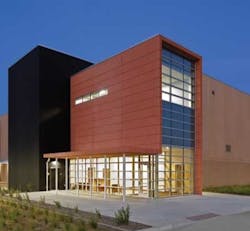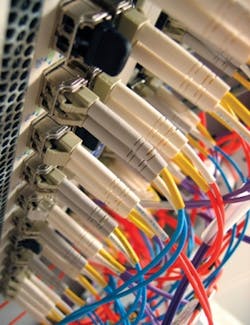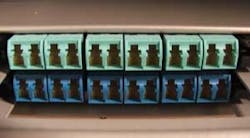Hospital data center sees bright future
Fiber infrastructure gives facility an edge accessing medical records.
By Heather Feltmann and staff, Corning Cable Systems
Accurate and immediately accessible medical records are critical to providing quality, affordable healthcare. Consequently, more and more hospitals are moving to electronic health record systems–a development that is challenging hospital data centers to provide real-time, 24x365 access to patient information, from dosage regimens to imaging studies.
One of the first hospital systems to take on that challenge is the St. Louis, MO-based Sisters of Mercy Health System. Mercy is the eighth largest Catholic health system in the nation and the 30th-largest among all healthcare systems, with 30,000 employees serving 26 Mercy hospitals in five states. In 2008, Mercy made the move to an Epic electronic medical record (EMR) system, which led to rethinking how Mercy handled data.
The Sisters of Mercy Health System's new 42,000-square-foot facility in Washington, MO includes just 10,000 square feet of raised-floor space. The user aimed for increased density in a smaller footprint than the traditional 2:1 ratio of building area to data center area.
"Over the years, as the Mercy Health System grew, each hospital had its own data center," said David Shaw, executive director of data center services for Mercy. "But when we moved to an electronic inpatient clinical information system, there were many advantages to having one central data center."
As a result, Corning Cable Systems became part of a team to build a new data center from scratch. According to Shaw, there were several reasons to build a new central facility. "Mercy wanted to be proactive in creating a state-of-the-art, end-to-end solution that would complement our reputation for high-quality reliable medical care. And we wanted to position Mercy ahead of the curve in complying with the Health Information Technology for Economic and Clinical Health [HITECH] Act. Improving data center uptime from 98 percent to 99.9 percent is critical to implementing a successful EMR system."
Another reason was to improve power and call-in capacity. "Mercy's old centers were converted office data centers," explains Shaw. "They had reached the point where a significant investment would be needed to make them fit into an EMR system."
The decision was made to build a new facility to ensure 24x7 availability of computing services with failsafe features designed to withstand seismic, weather, cooling, power, security and network outage problems.
"The new center was designed to be a Tier 3 facility, which means the Uptime Institute's standards for 99.982 percent availability," says Shaw. "By building a new data center from the ground up, we could get the level of concurrency and redundancy needed for our EMR system. All these requirements ended up driving our infrastructure-design decisions, including the use of Corning Cable Systems' Pretium EDGE solutions."
Building tomorrow's data center today
After evaluating 20 sites, ground was broken for the new data center in April 2008 in Washington, MO. Interestingly, the plans called for the 42,000-square-foot facility to use only 10,000 square feet of raised floor for the data center.
"People look at that and think it's a little bit odd, because the industry standard is a 2:1 ratio for building area to data center area," Shaw observes. "In that scenario, we would need 20,000 square feet of server floor space. But we were looking at how technology is moving and aimed for increasing density in a smaller footprint."
The facility was designed to employ 48-RU racks 88 inches high instead of more-typical 42-RU racks 78 inches in height. The racks are clustered in eight pods, which are standardized building blocks configured in a modular design that provides cooling and power.
An innovative infrastructure
Innovative thinking is evident in many aspects of the facility's infrastructure. For power, 415 VAC distribution is employed instead of typical 120/208 VAC distribution. That choice ended up reducing power consumption by 6 percent.
Sisters of Mercy Health System's executive director of data center services David Shaw (white shirt) and network manager Mike Williams (red shirt) inside the new data center.
With these energy-saving technologies came the decision to employ Corning Cable Systems' Pretium EDGE solutions. At the planning stage, key members of Mercy's information technology staff went to Corning's Broadband Testing Laboratory in Hickory, NC for validation testing.
"We went through and saw how everything worked," says Shaw. "We proved in our own mind that Corning's Pretium EDGE solutions worked as advertised. It was a team approach. Two of our technical specialists went to Corning Cable Systems, and then afterwards they also confirmed that the physical and switch layers played well together. Every area–the installer, network, storage–was considered. That's the benefit of working as a team with recognized names. It was great."
Complete solution provides edge
The Pretium EDGE solutions used at Mercy consist of optical trunks, harnesses, modules, housings and jumpers–all characterized by a reduced size, enabled by the improved bend resistance of Corning ClearCurve OM3 multimode optical fiber. The EDGE-04U connector housings used allow for the capacity of 576 fibers, doubling the industry standard density of 288 fibers in a 4U space. This solution proved ideal for the data center's demanding density requirements and helped to minimize the footprint on the raised-floor space.
Pretium EDGE trunk cables use the MTP connector, a 12-fiber optical array connector with a footprint similar to an SC simplex connector. The high-density connectors take up less space and significantly accelerated this installation.
Finally, the bend radius of Corning ClearCurve OM3 multimode optical fiber and reduced cable diameter allowed the cables to be routed through tight spaces without impacting performance.
The Pretium EDGE solutions modules break out the 12-fiber MTP connectors terminated on trunk cables into LC connectors, to facilitate patching into system equipment ports or patch panels.
"The small minimum bend radius of the ClearCurve multimode cabling was a key point from my perspective," says Shaw. "As an electronics engineer by past profession, I've seen the evolution of fiber. Attenuation through curve has always been a significant constraint. Minimizing bend-induced attenuation and maintaining a high-bandwidth operating margin were important in our high-density racks."
Mike Williams, Sisters of Mercy Health System's network manager, works with Corning Cable Systems' high-density EDGE-04U connector housings.
On time and under budget
It was also a plus that the Pretium EDGE solutions were designed to speed installation–thanks to preterminated cabling, pulling grips on the trunk cabling and the one-handed strain-relief operation on a snap-on trunk cable. The "green" advantages of low consumable packaging also contributed to less waste and a cleaner work site.
"The faster the network is installed, the faster we can implement the migration and start realizing the full potential of our EMR system," says Shaw. "I'm happy to say that our data facility is opening on time and under budget. Corning Cable Systems is a big part of that. Our use of pod techniques meant we could take full advantage of the Pretium EDGE solutions. Over 400 miles of fiber-optic cable will be handling the equivalent of over 650 million calls per second, with bandwidth capable of transferring the entire contents of the Library of Congress in less than 6.5 seconds.
"We're one of only two percent of health care organizations using a comprehensive EMR system. The easy installation and high-margin capacity of the Pretium EDGE solutions helped put us in the lead today, and will scale to handle more needs in the future."
Heather Feltmann is senior sales engineer with Corning Cable Systems (www.corning.com/cablesystems). Other Corning Cable Systems staff members also contributed to this article.
Past CIM Issues




